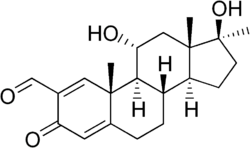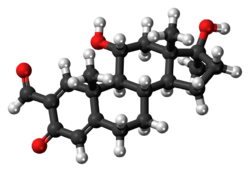Chemistry:Formebolone
 | |
 | |
| Clinical data | |
|---|---|
| Trade names | Esiclene, Hubernol, Metanor |
| Other names | Formyldienolone; 2-Formyl-11α-hydroxy-17α-methyl-δ1-testosterone |
| Routes of administration | Oral |
| Legal status | |
| Legal status |
|
| Identifiers | |
| |
| CAS Number | |
| PubChem CID | |
| ChemSpider | |
| UNII | |
| ChEMBL | |
| Chemical and physical data | |
| Formula | C21H28O4 |
| Molar mass | 344.451 g·mol−1 |
| 3D model (JSmol) | |
| |
| |
| | |
Formebolone (INN, BAN) (brand names Esiclene, Hubernol, Metanor), also known as formyldienolone, as well as 2-formyl-11α-hydroxy-17α-methyl-δ1-testosterone, is an orally active anabolic-androgenic steroid (AAS) described as an anticatabolic and anabolic drug that is or has been marketed in Spain and Italy.[1][2][3] As an AAS, it shows some anabolic activity, though it is inferior to testosterone in terms of potency, but is said to have virtually no androgenic activity.[4] Formebolone counteracts the catabolic effects (control of nitrogen balance) of potent glucocorticoids like dexamethasone phosphate.[4][5] A close analogue, roxibolone (and its long-acting ester variant decylroxibolone), shows similar antiglucocorticoid activity to formebolone but, in contrast, is devoid of activity as an AAS.[6]
Roxibolone has been found not to bind to the glucocorticoid receptor, and it has been suggested that the antiglucocorticoid activity of roxibolone and formebolone may instead be mediated by modulation of enzymatic processes.[7] Indeed, 11α- and 11β-hydroxyprogesterone (formebolone and roxibolone being 11α- and 11β-hydroxylated (respectively) similarly) are known to be potent inhibitors of 11β-hydroxysteroid dehydrogenase (11β-HSD), which is responsible for the biosynthesis of the potent endogenous glucocorticoids cortisol and corticosterone (from the precursors deoxycortisol and deoxycorticosterone, respectively).[8][9] However, formebolone was found to be a very weak inhibitor of 11β-HSD type 2 (IC50 > 10 μM), although this specific isoenzyme of 11β-HSD is responsible for the inactivation of glucocorticoids rather than their production.[10]
References
- ↑ Index Nominum 2000: International Drug Directory. Taylor & Francis. January 2000. pp. 471–. ISBN 978-3-88763-075-1. https://books.google.com/books?id=5GpcTQD_L2oC&pg=PA471.
- ↑ The Dictionary of Drugs: Chemical Data: Chemical Data, Structures and Bibliographies. Springer. 14 November 2014. pp. 577–. ISBN 978-1-4757-2085-3. https://books.google.com/books?id=0vXTBwAAQBAJ&pg=PA577%7CDATE%3D14+NOVEMBER+2014%7CPUBLISHER%3DSPRINGER%7CISBN%3D978-1-4757-2085-3%7CPAGES%3D577%E2%80%93%7D%7D%3C%2FREF%3E.
- ↑ Concise Dictionary of Pharmacological Agents: Properties and Synonyms. Springer Science & Business Media. 31 October 1999. pp. 125–. ISBN 978-0-7514-0499-9. https://books.google.com/books?id=mqaOMOtk61IC&pg=PA125.
- ↑ 4.0 4.1 "Metabolic studies with formebolone (2-formyl-17 (alpha)-methyl-androsta-1,4-diene-11 (alpha), 17 (beta)-diol-3-one) in humans". The Journal of International Medical Research 4 (2): 96–105. 1976. doi:10.1177/030006057600400203. PMID 799985.
- ↑ "Anticatabolic action of formebolone in the castrated rat treated with dexamethasone". Arzneimittel-Forschung 26 (9): 1673–1677. 1976. PMID 1036699.
- ↑ "Synthesis of 2-carboxy-11 beta, 17 beta-dihydroxy-17-methyl-1, 4-androstadien-3-one and related compounds". Steroids 43 (3): 271–282. March 1984. doi:10.1016/0039-128x(84)90045-x. PMID 6523544.
- ↑ "Regulation of the androgen and glucocorticoid receptors in rat and mouse skeletal muscle cytosol". Endocrinology 108 (4): 1431–1440. April 1981. doi:10.1210/endo-108-4-1431. PMID 6970661.
- ↑ "11 alpha- and 11 beta-hydroxyprogesterone, potent inhibitors of 11 beta-hydroxysteroid dehydrogenase (isoforms 1 and 2), confer marked mineralocorticoid activity on corticosterone in the ADX rat". Endocrinology 136 (4): 1809–1812. April 1995. doi:10.1210/endo.136.4.7895695. PMID 7895695.
- ↑ "11 alpha- and 11 beta-hydroxyprogesterone, potent inhibitors of 11 beta-hydroxysteroid dehydrogenase, possess hypertensinogenic activity in the rat". Hypertension 27 (3 Pt 1): 421–425. March 1996. doi:10.1161/01.hyp.27.3.421. PMID 8698448.
- ↑ "The anabolic androgenic steroid fluoxymesterone inhibits 11β-hydroxysteroid dehydrogenase 2-dependent glucocorticoid inactivation". Toxicological Sciences 126 (2): 353–361. April 2012. doi:10.1093/toxsci/kfs022. PMID 22273746.
{{Navbox
| name = Androgens and antiandrogens | title = Androgens and antiandrogens | state = collapsed | listclass = hlist | groupstyle = text-align:center;
| group1 = Androgens
(incl. AAS)
| list1 =
| group2 = Antiandrogens | list2 = {{Navbox|child | groupstyle = text-align:center; | groupwidth = 9em;
| group1 = AR antagonists | list1 =
- Steroidal: Abiraterone acetate
- Canrenone
- Chlormadinone acetate
- Cyproterone acetate
- Delmadinone acetate
- Dienogest
- Drospirenone
- Medrogestone
- Megestrol acetate
- Nomegestrol acetate
- Osaterone acetate
- Oxendolone
- Potassium canrenoate
- Spironolactone
- Nonsteroidal: Apalutamide
- Bicalutamide
- Cimetidine
- Darolutamide
- Enzalutamide
- Flutamide
- Ketoconazole
- Nilutamide
- Seviteronel†
- Topilutamide (fluridil)
| group2 = Steroidogenesis| list2 =
inhibitors
| 5α-Reductase | |
|---|---|
| Others |
| group3 = Antigonadotropins | list3 =
- D2 receptor antagonists (prolactin releasers) (e.g., domperidone, metoclopramide, risperidone, haloperidol, chlorpromazine, sulpiride)
- Estrogens (e.g., bifluranol, [[diethylstilbestrol, estradiol, estradiol esters, ethinylestradiol, ethinylestradiol sulfonate, paroxypropione)
- GnRH agonists (e.g., leuprorelin)
- GnRH antagonists (e.g., cetrorelix)
- Progestogens (incl., chlormadinone acetate, [[cyproterone acetate, hydroxyprogesterone caproate, gestonorone caproate, [[Chemistry:Medroxyprogesterone medroxyprogesterone acetate, Chemistry:Megestrol acetate|megestrol acetate]])
| group4 = Others | list4 =
- Androstenedione immunogens: Androvax (androstenedione albumin)
- Ovandrotone albumin (Fecundin)
}}
| liststyle = background:#DDDDFF;| list3 =
- #WHO-EM
- ‡Withdrawn from market
- Clinical trials:
- †Phase III
- §Never to phase III
- See also
- Androgen receptor modulators
- Estrogens and antiestrogens
- Progestogens and antiprogestogens
- List of androgens/anabolic steroids
}}
 |

